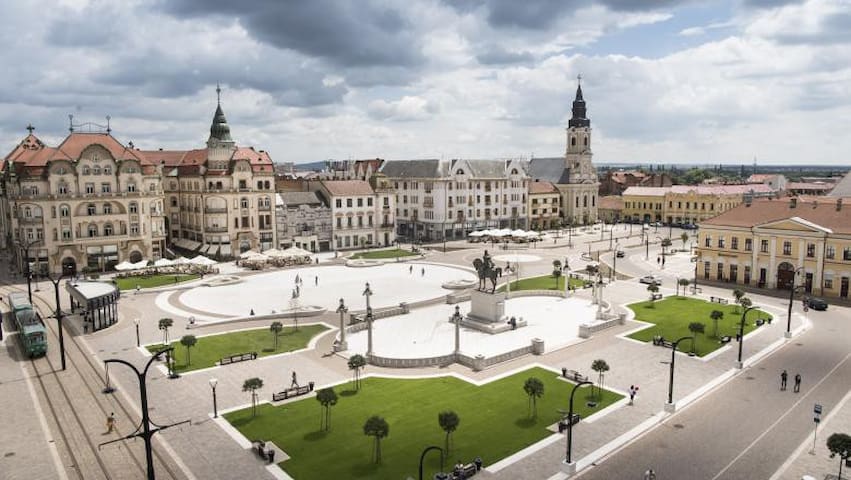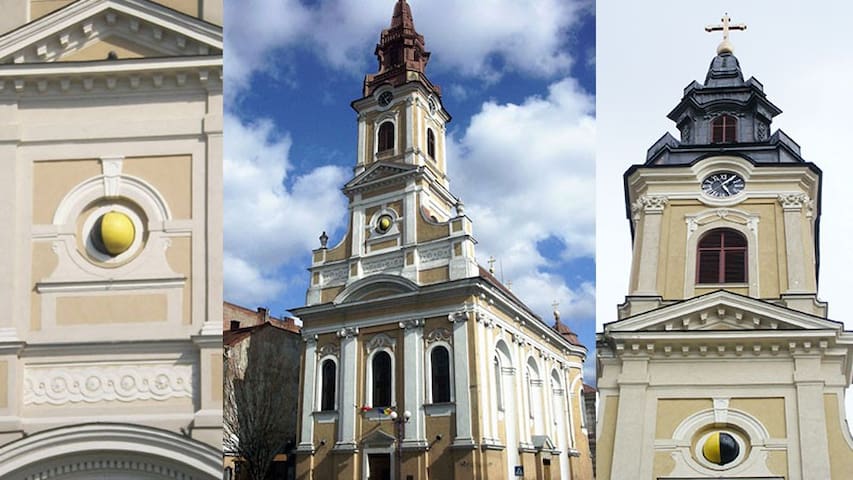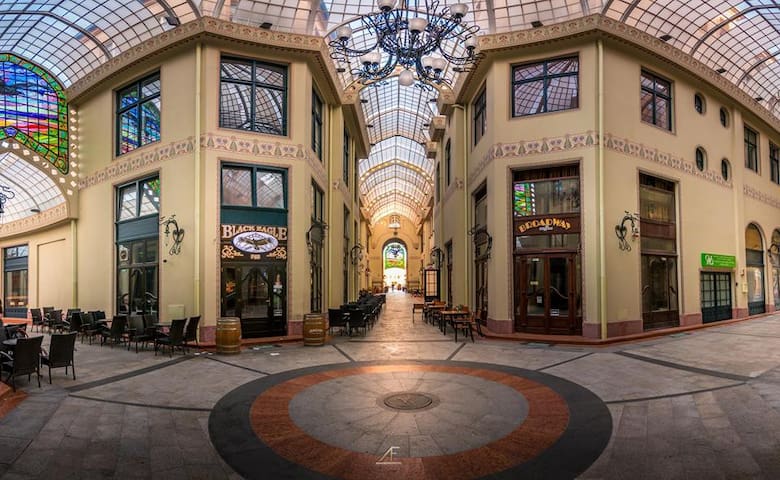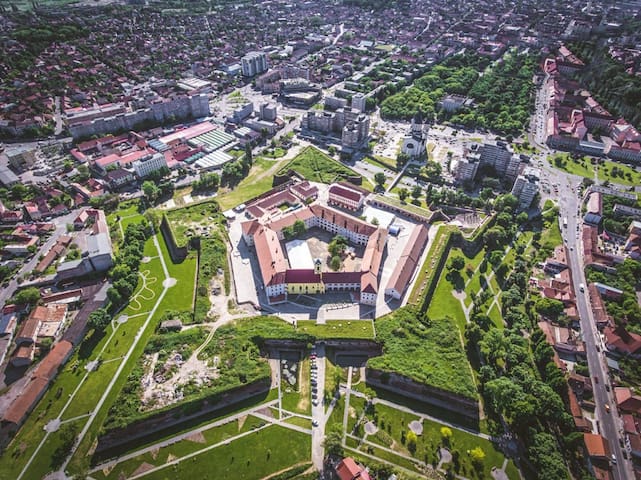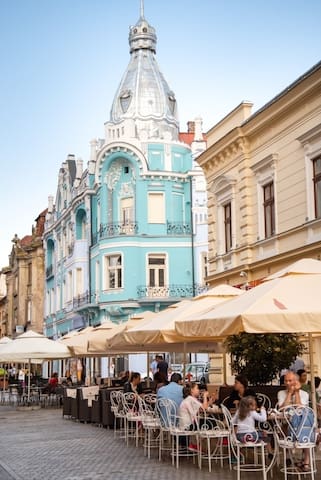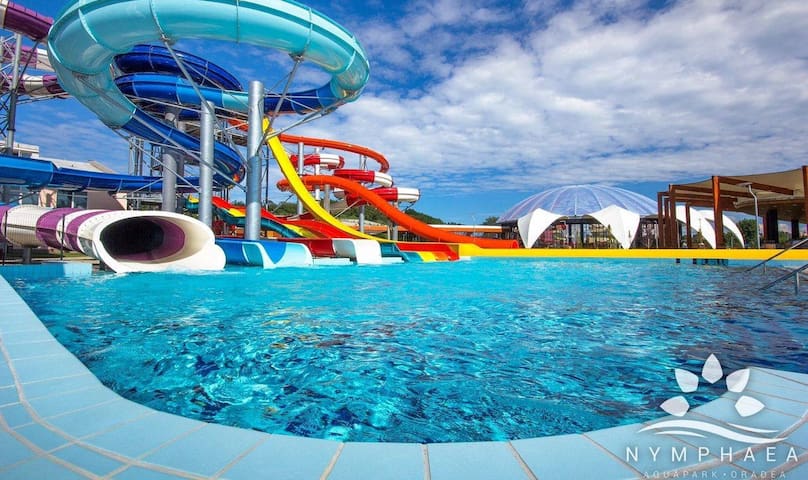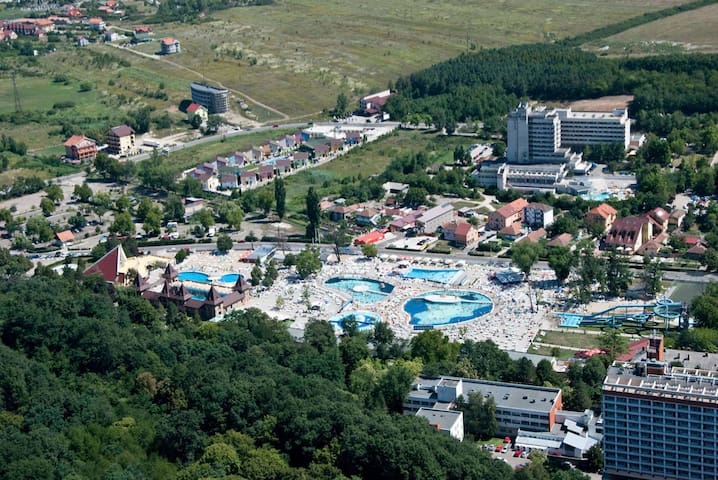Vizitarea obiectivelor turistice
I really recommend Piata Unirii (Union Square) because it's the biggest concentration of historical buildings.
Here are a lot of places to visit like :City Hall, Black Eagle Palace, Zion Synagogue, Moon Church etc.
18 locals raden deze aan
Piața Unirii
Piața UniriiI really recommend Piata Unirii (Union Square) because it's the biggest concentration of historical buildings.
Here are a lot of places to visit like :City Hall, Black Eagle Palace, Zion Synagogue, Moon Church etc.
Biserica cu Luna (Moon Church) is a church with an astronomical clock depicting the phases of the moon, a unique feature in Europe.
This name derives from the mechanism installed in the church tower in 1793. The clock and the moon are the work of George Rueppe, an innovative mechanic from Oradea. The mechanism rotating the moon is designed to make a full rotation on its axis in 28 days, thus indicating the moon phases, depending on the daily cycle marked by the clock mechanism. Inside the Moon Church you can visit a representative museum, with particularly beautiful Orthodox church-related objects.
Kathedraal van de Ontslaping van de Moeder Gods
2 Piața UniriiBiserica cu Luna (Moon Church) is a church with an astronomical clock depicting the phases of the moon, a unique feature in Europe.
This name derives from the mechanism installed in the church tower in 1793. The clock and the moon are the work of George Rueppe, an innovative mechanic from Oradea. The mechanism rotating the moon is designed to make a full rotation on its axis in 28 days, thus indicating the moon phases, depending on the daily cycle marked by the clock mechanism. Inside the Moon Church you can visit a representative museum, with particularly beautiful Orthodox church-related objects.
In 1878, the Jewish community builds, on the bank of Crișul Repede river, a monumental synagogue with 1000 places, dominated by a huge central dome. The project was designed by Busch David in a neo-Moorish style and executed by Rimanoczy Kalman (the father). The interior fresco belongs to the Kosice painter Horovitz Mor. The interior and exterior decorations are of Moorish inspiration.
12 locals raden deze aan
Neolog Synagoge Sion
22 Strada IndependențeiIn 1878, the Jewish community builds, on the bank of Crișul Repede river, a monumental synagogue with 1000 places, dominated by a huge central dome. The project was designed by Busch David in a neo-Moorish style and executed by Rimanoczy Kalman (the father). The interior fresco belongs to the Kosice painter Horovitz Mor. The interior and exterior decorations are of Moorish inspiration.
This ensemble of buildings is one of the monumental architectural works in Oradea and Transylvania, typical for the secession style. The architects Komor Marcell and Jakab Dezső won the contest for the construction of this complex. Two Jewish lawyers, Dr. Kurlander Ede and Dr. Emil Adorjan, decided to finance, using their own resources, the construction of a noteworthy building in Oradea. The work started in 1907, under the supervision of the civil engineer Sztarill Ferenc, and in December 1908 the building was completed. Consisting of two unequal and asymmetrical buildings, connected to a third one, placed in the middle and more isolated, the complex housed a theatre, ballrooms, a casino and offices. The Y-shaped gallery (passage) has three entrances. The Vittorio Emanuele Gallery in Milan inspired the glass-covered interior. The gallery or the Passage, as the local people know it, concentrates the most popular bars, coffee houses and pubs in the city, being the entertainment high spot of the city.
8 locals raden deze aan
Pasajul Vulturul Negru
Pasajul Vulturul NegruThis ensemble of buildings is one of the monumental architectural works in Oradea and Transylvania, typical for the secession style. The architects Komor Marcell and Jakab Dezső won the contest for the construction of this complex. Two Jewish lawyers, Dr. Kurlander Ede and Dr. Emil Adorjan, decided to finance, using their own resources, the construction of a noteworthy building in Oradea. The work started in 1907, under the supervision of the civil engineer Sztarill Ferenc, and in December 1908 the building was completed. Consisting of two unequal and asymmetrical buildings, connected to a third one, placed in the middle and more isolated, the complex housed a theatre, ballrooms, a casino and offices. The Y-shaped gallery (passage) has three entrances. The Vittorio Emanuele Gallery in Milan inspired the glass-covered interior. The gallery or the Passage, as the local people know it, concentrates the most popular bars, coffee houses and pubs in the city, being the entertainment high spot of the city.
The City Hall Palace and Tower THE BUILDING IS THE WORK OF ARCHITECT RIMANÓCZY KÁLMÁN JR., WHO IN 1896 WON THE PROJECT CONTEST FOR THE CONSTRUCTION AND DESIGN OF THE CITY HALL. THE SOLEMN INAUGURATION MEETING OF THE LOCAL COUNCIL WAS HELD IN THE NEWLY-BUILT PALACE ON THE 10th OF JANUARY 1904. THE CITY HALL TOWER With a height of about 50 m and 4 main levels, three of which have observation decks, the City Hall Palace Tower is also hosts the clock announcing the exact time in Oradea. The mechanism of the clock, called the "mother clock", strikes every hour and plays Iancu's March. The local watchmaker Mezey Dezső built the mechanism in the early twentieth century, in 1904. The clock survived two world wars, while the roof and wall of the tower survived the two great fires of 1917 and 1944. The watch dial retains even today bullet holes from gunfires shot during the Second World War. The second level was also the observation point of the city firefighter on duty. Fires were announced by ringing a bell, depending on the area where the fire started. In the daytime, a red flag was unfurled in the direction of the fire, while at night an electric projector was used.
10 locals raden deze aan
Stadhuis van Oradea
1 Piața UniriiThe City Hall Palace and Tower THE BUILDING IS THE WORK OF ARCHITECT RIMANÓCZY KÁLMÁN JR., WHO IN 1896 WON THE PROJECT CONTEST FOR THE CONSTRUCTION AND DESIGN OF THE CITY HALL. THE SOLEMN INAUGURATION MEETING OF THE LOCAL COUNCIL WAS HELD IN THE NEWLY-BUILT PALACE ON THE 10th OF JANUARY 1904. THE CITY HALL TOWER With a height of about 50 m and 4 main levels, three of which have observation decks, the City Hall Palace Tower is also hosts the clock announcing the exact time in Oradea. The mechanism of the clock, called the "mother clock", strikes every hour and plays Iancu's March. The local watchmaker Mezey Dezső built the mechanism in the early twentieth century, in 1904. The clock survived two world wars, while the roof and wall of the tower survived the two great fires of 1917 and 1944. The watch dial retains even today bullet holes from gunfires shot during the Second World War. The second level was also the observation point of the city firefighter on duty. Fires were announced by ringing a bell, depending on the area where the fire started. In the daytime, a red flag was unfurled in the direction of the fire, while at night an electric projector was used.
ORADEA MEDIAEVAL FORTRESS HISTORY AND EVENTS WITNESSING THE PASSAGE OF TIME If nowadays we can hear about history in school and see it in museums, this is the best place to feel it. The fortress has witnessed the passage of time and continues to keep its old charm. It tells everlasting stories and passes on to its visitors some of the history it knows. The Fortress of Oradea is nowadays the living proof of those historical times and it continues to remind everyone of what it used to represent. Also, it is one of the symbols of the city along Crișul Repede river and the heart of its cultural events. LIVING HISTORY! The Mediaeval music concerts held here will take you back to an atmosphere of already forgotten times, while fighting demonstrations and guided tours accompanied by weapon and armour presentations will steal your attention. The Fortress is no longer literally under siege, but still there are many tourists and local people visiting it, our of a wish to live a bit of real history. Here are some of the new functions of the Fortress: - the City Museum - the Museum of Bread - the Bakery, dating more than 3 centuries back - cafés - traditional restaurants
44 locals raden deze aan
Oradea Fortress
ORADEA MEDIAEVAL FORTRESS HISTORY AND EVENTS WITNESSING THE PASSAGE OF TIME If nowadays we can hear about history in school and see it in museums, this is the best place to feel it. The fortress has witnessed the passage of time and continues to keep its old charm. It tells everlasting stories and passes on to its visitors some of the history it knows. The Fortress of Oradea is nowadays the living proof of those historical times and it continues to remind everyone of what it used to represent. Also, it is one of the symbols of the city along Crișul Repede river and the heart of its cultural events. LIVING HISTORY! The Mediaeval music concerts held here will take you back to an atmosphere of already forgotten times, while fighting demonstrations and guided tours accompanied by weapon and armour presentations will steal your attention. The Fortress is no longer literally under siege, but still there are many tourists and local people visiting it, our of a wish to live a bit of real history. Here are some of the new functions of the Fortress: - the City Museum - the Museum of Bread - the Bakery, dating more than 3 centuries back - cafés - traditional restaurants
Teatrul de Stat din Oradea|Teatrul de Stat – the State Theatre in the heart of the city, plans for which were designed by two Austrian architects who had built around 100 theaters and opera houses in Europe by the end of the 19th century.
22 locals raden deze aan
Regina Maria Theater
4 Piața Regele Ferdinand ITeatrul de Stat din Oradea|Teatrul de Stat – the State Theatre in the heart of the city, plans for which were designed by two Austrian architects who had built around 100 theaters and opera houses in Europe by the end of the 19th century.
Republicii (Republic) Walkway has had several names: Nagy utca (Strada Mare, Grand Street) in 1727, Fő utca (Strada Principală, Main Street) by 1890, Rakoczi út starting from 1900, Regele Ferdinand (King Ferdinand) Street starting from 1920, and, after 1945, Republicii Street.
Ever since the final decades of the 19th century, it has remained a main arterial road, connecting the main railway station to the center of the city. Development of the area was kickstarted especially after the Main Railway Station started functioning, when several plots of land were made available to those who wished to erect residential buildings, as well as buildings that were both residential and non-residential. At the start of the 20th century, aside from the houses, this artery hosted two hospitals and several buildings that belonged to the state railway company.
The majority of the Secession palaces were built on this artery that undulates from the area of the main railway station all the way to Ferdinand Square: the Rimanóczy Kálmán-Senior Palace, the Stern Palace, the Apollo Palace, and the Moskovits Miksa Palace.
Savor an ice cream, have a taste of our traditional cuisine, drink a cup of coffee or just take a stroll down Republicii Walkway!
Calea Republicii
Calea RepubliciiRepublicii (Republic) Walkway has had several names: Nagy utca (Strada Mare, Grand Street) in 1727, Fő utca (Strada Principală, Main Street) by 1890, Rakoczi út starting from 1900, Regele Ferdinand (King Ferdinand) Street starting from 1920, and, after 1945, Republicii Street.
Ever since the final decades of the 19th century, it has remained a main arterial road, connecting the main railway station to the center of the city. Development of the area was kickstarted especially after the Main Railway Station started functioning, when several plots of land were made available to those who wished to erect residential buildings, as well as buildings that were both residential and non-residential. At the start of the 20th century, aside from the houses, this artery hosted two hospitals and several buildings that belonged to the state railway company.
The majority of the Secession palaces were built on this artery that undulates from the area of the main railway station all the way to Ferdinand Square: the Rimanóczy Kálmán-Senior Palace, the Stern Palace, the Apollo Palace, and the Moskovits Miksa Palace.
Savor an ice cream, have a taste of our traditional cuisine, drink a cup of coffee or just take a stroll down Republicii Walkway!
Enjoying a smart design and in line with the latest technologies, Aquapark Nymphaea encompasses over an area of 7 hectares a fascinating world dedicated equally to fun and adrenaline and also to ultimate relaxation and wellbeing. Having an arsenal consisting of 10 exciting slides, 15 swimming and relaxation pools, play structures dedicated to children, 6 sauna, massage salons, Turkish bath, sport courts and restaurants, Nymphaea is the largest waterpark in this region of Europe. It will unveil an unreal world, a small tropical island, giving you a perfect day of recreation in any season!
40 locals raden deze aan
Aquapark Nymphaea Orade
13 B Aleea ȘtranduluiEnjoying a smart design and in line with the latest technologies, Aquapark Nymphaea encompasses over an area of 7 hectares a fascinating world dedicated equally to fun and adrenaline and also to ultimate relaxation and wellbeing. Having an arsenal consisting of 10 exciting slides, 15 swimming and relaxation pools, play structures dedicated to children, 6 sauna, massage salons, Turkish bath, sport courts and restaurants, Nymphaea is the largest waterpark in this region of Europe. It will unveil an unreal world, a small tropical island, giving you a perfect day of recreation in any season!
City/town information
Băile Felix (Hungarian: Félixfürdő) is a thermal spa resort near the commune of Sânmartin in Bihor County, Transylvania, Romania. Băile Felix is at a close distance to Oradea, a major city in western Romania.
The resorts host many mineral springs with thermal (20-48°C), sulphuric, calcic, sodic, rich in bicarbonate waters known since the beginning of the millennium. The soothing effect of the waters on articular and muscular pain and on various rheumatic neuralgias accounts for the fame of cures in the resort for the treatment of inflammatory rheumatic diseases (rheumatic polyarthritis, rheumatoid spondylitis, conditions after acute articular rheumatism), degenerative and articular rheumatic diseases, central and peripheral neurological disorders, gynecological diseases, post-traumatic conditions, endocrine disorders.
The facilities of the two resorts offer treatment of rheumatism and neurological and gynecological diseases. The modern medical base has at its disposal various facilities for procedures involving electrotherapy, hydrotherapy, aerosols, massage, paraffin packing and other water treatments.
26 locals raden deze aan
Băile Felix
Băile Felix (Hungarian: Félixfürdő) is a thermal spa resort near the commune of Sânmartin in Bihor County, Transylvania, Romania. Băile Felix is at a close distance to Oradea, a major city in western Romania.
The resorts host many mineral springs with thermal (20-48°C), sulphuric, calcic, sodic, rich in bicarbonate waters known since the beginning of the millennium. The soothing effect of the waters on articular and muscular pain and on various rheumatic neuralgias accounts for the fame of cures in the resort for the treatment of inflammatory rheumatic diseases (rheumatic polyarthritis, rheumatoid spondylitis, conditions after acute articular rheumatism), degenerative and articular rheumatic diseases, central and peripheral neurological disorders, gynecological diseases, post-traumatic conditions, endocrine disorders.
The facilities of the two resorts offer treatment of rheumatism and neurological and gynecological diseases. The modern medical base has at its disposal various facilities for procedures involving electrotherapy, hydrotherapy, aerosols, massage, paraffin packing and other water treatments.

